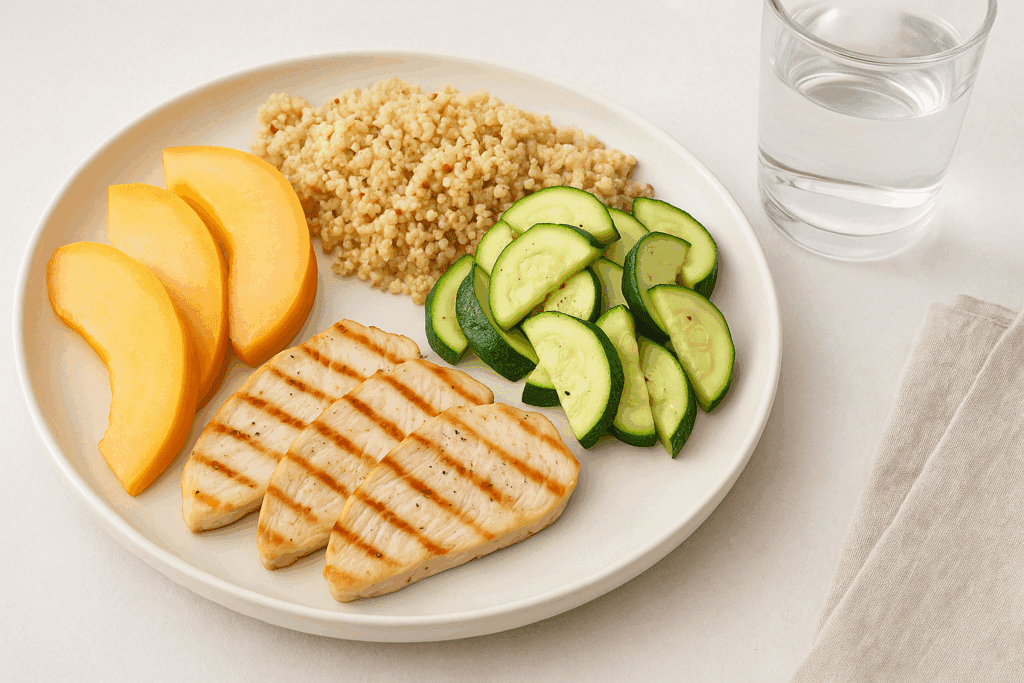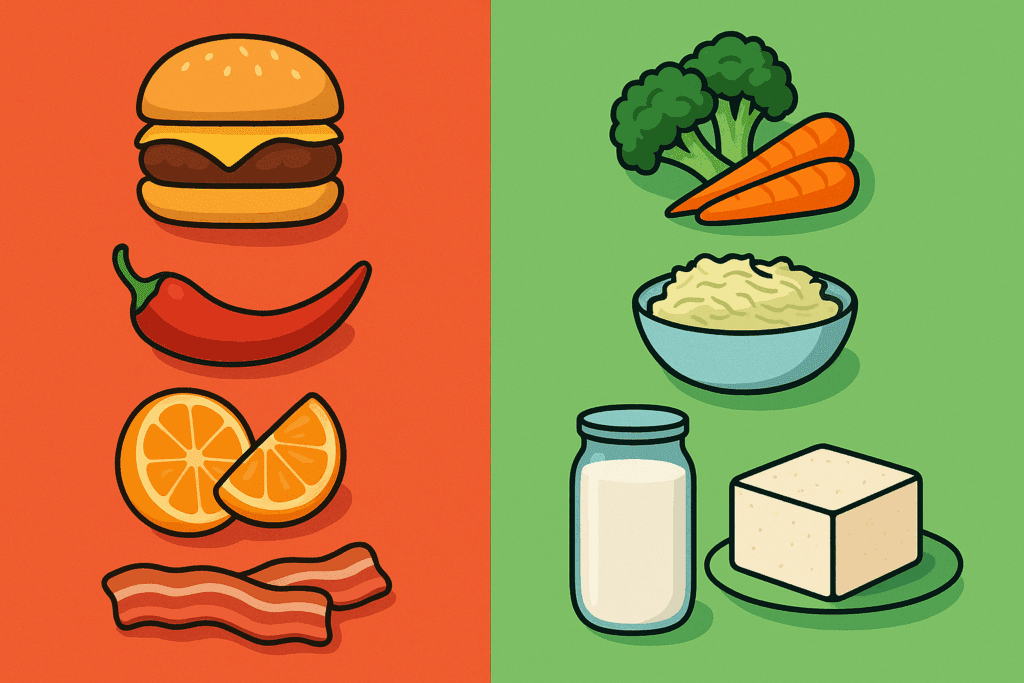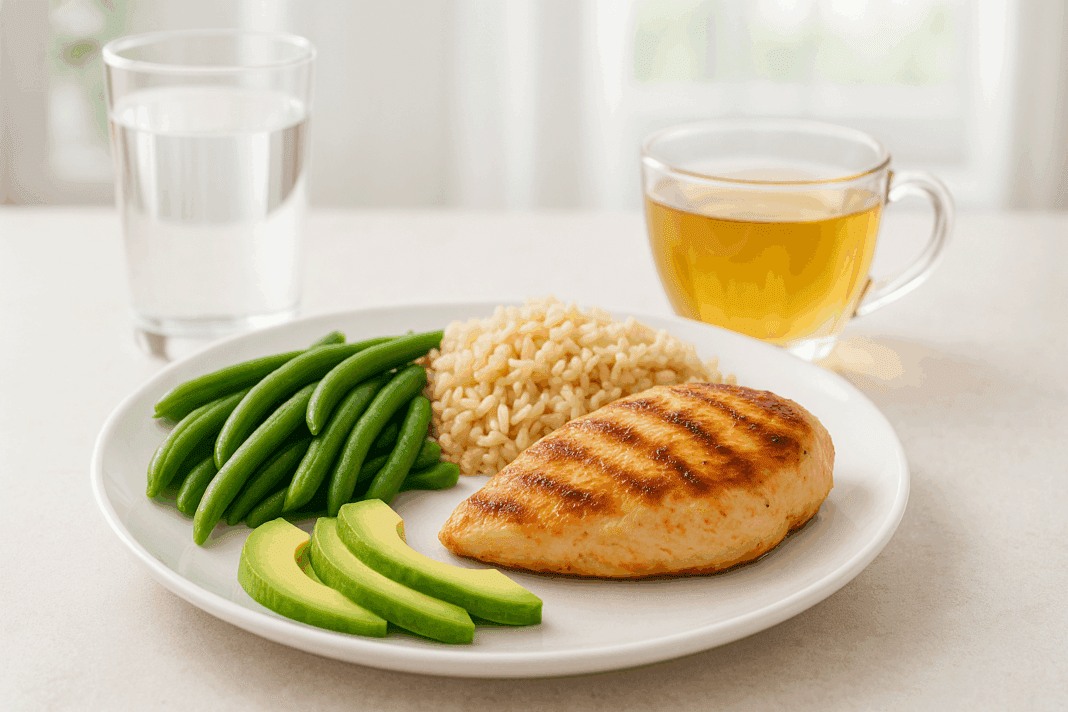Understanding what foods to avoid with GERD is essential for anyone seeking lasting relief from acid reflux and its uncomfortable symptoms. Gastroesophageal reflux disease, or GERD, is a chronic condition where stomach acid flows back into the esophagus, causing symptoms such as heartburn, regurgitation, and even respiratory issues. While medication can offer temporary relief, dietary modification remains one of the most effective and sustainable strategies for managing GERD. By eliminating trigger foods and embracing gut-friendly alternatives, individuals can significantly reduce flare-ups and improve digestive health. This guide explores the foundational principles of the acid reflux diet, details what foods to avoid with GERD, and offers practical advice for creating a dietary plan that supports holistic gut wellness.
You may also like: The Ultimate Guide to Gut Healthy Meals: Best Meals for Gut Health and Nourishing Recipes You’ll Love

Recognizing the Impact of Diet on GERD and Acid Reflux
The relationship between diet and GERD is well-established in both clinical research and patient experience. Certain foods have been found to relax the lower esophageal sphincter (LES), the muscle responsible for keeping stomach acid in the stomach. When this sphincter is weakened, acid can easily move upward into the esophagus, leading to the burning sensation commonly known as heartburn. Additionally, high-fat, spicy, or acidic foods can irritate the esophageal lining, compounding the discomfort. It is important to understand that while everyone may have individual sensitivities, certain common culprits consistently appear across populations.
In particular, dietary modifications for GERD are a cornerstone of long-term symptom control. While antacids and proton pump inhibitors may reduce the intensity of symptoms, they do not address the root cause. A strategic acid reflux dietary modification, especially when combined with lifestyle changes such as weight management and sleeping habits, can significantly improve outcomes. Understanding the nuances of what foods trigger acid reflux allows individuals to make informed decisions about meal planning and eating behaviors.

What Foods to Avoid with GERD: Identifying Common Triggers
A central part of the GERD diet is knowing what foods to avoid with GERD. Among the most well-documented triggers are high-fat foods, which delay stomach emptying and increase the risk of acid backflow. Fried foods, full-fat dairy products, and fatty cuts of meat fall into this category. Similarly, spicy foods containing capsaicin can irritate the digestive tract, worsening acid reflux symptoms. Tomato-based sauces, citrus fruits, and vinegar-rich dressings are also problematic due to their high acidity.
Caffeine and carbonated beverages are other top contributors. Coffee, even decaffeinated, and sodas can weaken the LES and increase intra-abdominal pressure, creating a perfect storm for reflux. Chocolate, often overlooked, is a potent trigger due to its combination of caffeine, fat, and theobromine, all of which relax the LES. Alcohol, especially wine and beer, not only relaxes the sphincter but also stimulates stomach acid production, making it a dual threat. Understanding what foods cause gastric reflux and avoiding them consistently can greatly improve symptom control.
Exploring the Ten Worst Foods for Acid Reflux
Among the many dietary offenders, there is a clear hierarchy of triggers. The ten worst foods for acid reflux often include those that are both acidic and fatty. Topping this list are fried foods such as onion rings, French fries, and fried chicken. These are particularly damaging because they remain in the stomach longer and exert pressure on the LES. Closely following are processed meats like sausages, pepperoni, and bacon, which are not only high in fat but also seasoned with reflux-inducing spices.
Other offenders include pizza, which combines acidic tomato sauce with high-fat cheese and processed meats; citrus fruits such as oranges and grapefruits; and full-fat dairy products, including whole milk, butter, and cream-based sauces. Chocolate and caffeinated beverages are nearly always present on these lists. Peppermint, while commonly thought to soothe digestion, actually relaxes the LES and can worsen symptoms. Recognizing these foods as consistent contributors to acid reflux is key for effective dietary modification.

The Science Behind Dietary Modifications for GERD
Dietary modifications for GERD are supported by both clinical research and empirical patient outcomes. The physiology of reflux reveals that controlling stomach acid production and minimizing pressure on the LES are central goals. By replacing high-fat and acidic foods with lighter, low-acid options, patients often experience reduced symptom frequency and severity. For example, opting for lean proteins like grilled chicken or tofu, and pairing them with alkaline vegetables such as spinach and broccoli, supports a balanced and GERD-friendly meal.
Fiber-rich foods, particularly those high in soluble fiber, play a crucial role in acid reflux dietary modification. Oats, flaxseeds, and bananas not only promote digestion but also help absorb excess stomach acid. These foods fall into the category of best foods for acid reflux and are frequently recommended by gastroenterologists. The inclusion of whole grains and non-citrus fruits further supports gut health while minimizing irritation. Understanding the mechanisms by which certain foods aggravate or soothe the digestive tract helps individuals make evidence-based choices for long-term relief.
Acid Reflux Diet Fundamentals: Building a Balanced GERD-Friendly Plate
Constructing a balanced acid reflux diet involves more than just avoiding specific foods. It also requires a shift in meal composition, portion sizes, and timing. Smaller, more frequent meals reduce the burden on the stomach and lower the likelihood of acid escaping into the esophagus. Timing is equally important, with experts recommending a gap of at least two to three hours between eating and lying down. This allows for more complete digestion and prevents nocturnal reflux.
A GERD-friendly plate typically includes a lean protein source, such as skinless turkey or lentils; complex carbohydrates like quinoa or brown rice; and non-acidic vegetables such as zucchini, green beans, or carrots. Healthy fats, like those found in avocados and almonds, can be included in moderation. Water should be the primary beverage, with herbal teas such as chamomile or ginger serving as gentle digestive aids. Avoiding late-night snacks and heavy dinners is also a crucial part of the overall acid reflux diet strategy.

What Foods to Avoid with GERD When Dining Out
Navigating restaurants and takeout while managing GERD can be a challenge, especially since many menu items are rich in fat, salt, and spice. However, a bit of planning can make it manageable. One of the most practical approaches is to review menus in advance and identify GERD-safe options. Grilled, steamed, or baked dishes are preferable to fried or sautéed items. Asking for sauces and dressings on the side allows for better control of potential triggers.
When dining out, individuals should steer clear of common culprits such as tomato-based pasta sauces, creamy dressings, and carbonated beverages. Opting for grilled fish, a side of steamed vegetables, and a plain baked potato is often a safer choice. Ethnic cuisines such as Japanese and Mediterranean can offer GERD-friendly alternatives, such as grilled chicken skewers, rice-based dishes, or cucumber salads. Practicing mindfulness during meals, such as eating slowly and avoiding overeating, further reduces the risk of reflux during and after dining out.

What Foods to Avoid with GERD During Holiday Meals and Social Gatherings
Social occasions often come with indulgent meals and tempting treats that can spell disaster for those with GERD. Understanding what foods to avoid with GERD during holidays is crucial for preventing uncomfortable flare-ups. Holiday dishes often contain rich gravies, buttery sides, and spicy casseroles that can overburden the digestive system. Desserts, particularly chocolate-based ones, are especially problematic.
Planning ahead is essential. Bringing a GERD-friendly dish to share ensures there is at least one safe option. Focusing on simple foods like roasted vegetables, turkey breast without the skin, and plain rice can provide comfort during the festivities. Avoiding alcohol, even in small amounts, is important, as it is a well-documented trigger. Drinking herbal teas or infused water can offer a pleasant alternative. Recognizing personal limits and politely declining trigger foods helps preserve digestive comfort while still participating in social joy.
How to Get Rid of Acid Reflux Fast: Emergency Dietary Tweaks
Even with the most carefully planned diet, occasional flare-ups can occur. Knowing how to get rid of acid reflux fast using dietary choices can provide immediate relief. Choosing foods that neutralize stomach acid immediately, such as bananas, oatmeal, and chamomile tea, can soothe the esophagus and reduce burning sensations. Ginger, known for its anti-inflammatory properties, is another effective option, whether consumed as tea or added to meals.
Remaining upright after meals is essential, as gravity helps keep acid in the stomach. Chewing sugar-free gum stimulates saliva production, which can neutralize acid and improve esophageal clearance. Avoiding cold water, which can slow digestion, and choosing room-temperature beverages may offer additional support. These fast-acting remedies, while not substitutes for long-term management, are valuable tools for coping with unexpected symptoms.
Best Diet for GERD: Sustainable Eating for Long-Term Relief
Identifying the best diet for GERD involves more than removing trigger foods; it’s about cultivating habits that promote digestive harmony. The Mediterranean diet, with its emphasis on whole foods, lean proteins, and healthy fats, has been shown to reduce GERD symptoms in several studies. This dietary pattern includes a variety of gut-friendly ingredients such as olive oil, fish, legumes, and leafy greens, all of which support both gut health and reflux prevention.
Plant-based diets are another effective approach, as they minimize exposure to animal fats and emphasize alkaline-forming foods. Incorporating probiotic-rich options like yogurt (with low fat and no added sugar) or fermented vegetables can further aid in gut balance. These elements not only reduce inflammation but also promote motility and nutrient absorption. The key to success lies in personalization—adapting the best diet for GERD to individual preferences and tolerances makes the plan sustainable and enjoyable.

How to Cure GERD Naturally: Integrating Holistic Supplements and Lifestyle
Many individuals explore how to cure GERD naturally, seeking alternatives to long-term medication use. While complete “cure” may not be realistic for everyone, natural strategies can significantly reduce symptom burden. Supplements such as slippery elm, deglycyrrhizinated licorice (DGL), and aloe vera have been traditionally used to soothe the digestive tract and reduce inflammation. These remedies, when used under professional guidance, can complement dietary and lifestyle efforts.
Lifestyle modifications remain a cornerstone of natural GERD management. Elevating the head of the bed, maintaining a healthy weight, and reducing stress through yoga or mindfulness practices all contribute to better symptom control. Avoiding tight clothing, especially after meals, and refraining from smoking are additional protective measures. Combining holistic supplements with an acid reflux diet and healthy routines forms a comprehensive, natural approach to GERD relief.
List of Foods to Eat with Acid Reflux: Safe Choices for Daily Wellness
For every item on the list of foods to avoid with GERD, there is a corresponding set of safe and nourishing alternatives. The list of foods to eat with acid reflux includes options that are low in fat, non-acidic, and easy to digest. Cooked vegetables like carrots, green beans, and broccoli are excellent staples. Lean proteins, such as grilled turkey, tofu, and white fish, provide essential nutrients without aggravating symptoms.
Complex carbohydrates including oats, brown rice, and whole grain pasta offer energy while promoting digestive stability. Non-citrus fruits such as bananas, melons, and apples (peeled) are gentle on the stomach and can be enjoyed as snacks or dessert. Herbal teas, particularly those containing chamomile or ginger, support the gut and provide hydration without triggering reflux. Creating meals with these ingredients allows for a satisfying, balanced, and GERD-friendly diet.
What Foods Aggravate Acid Reflux and Why They Should Be Minimized
Understanding what foods aggravate acid reflux helps reinforce the importance of careful dietary choices. Beyond the obvious triggers like spicy foods and caffeine, even healthy items such as raw onions, garlic, and certain legumes can provoke symptoms in sensitive individuals. These foods may increase gas production, slow digestion, or relax the LES, leading to discomfort.
Tracking symptoms through a food diary can illuminate specific patterns and help tailor the diet to individual responses. It is also important to consider food combinations; for example, combining acidic tomatoes with fatty cheese and processed meat, as in pizza, compounds the risk of reflux. Being mindful of these effects encourages a more nuanced, personalized approach to dietary management. As with any health strategy, flexibility and awareness are key.
What Helps Acid Reflux Fast: Proactive and Preventive Solutions
While long-term dietary adjustments form the backbone of acid reflux management, it’s equally important to know what helps acid reflux fast. In addition to eating soothing foods like oatmeal or drinking herbal tea, posture plays a critical role. Staying upright after meals and using a wedge pillow while sleeping can minimize nighttime reflux. Deep breathing exercises and stress management techniques also help regulate digestive function and reduce pressure on the LES.
Hydration is another simple yet powerful tool. Drinking adequate water throughout the day dilutes stomach acid and supports peristalsis, the rhythmic contraction of digestive muscles. For those prone to flare-ups, carrying a travel-sized bottle of aloe vera juice or ginger tea can offer immediate relief. These strategies empower individuals to respond quickly to symptoms without relying solely on pharmaceuticals.
Frequently Asked Questions (FAQ): What Foods to Avoid with GERD and How to Achieve Lasting Digestive Relief
What Foods to Avoid with GERD in the Context of a Vegetarian Diet?
While traditional GERD diets focus on common triggers like fried foods and chocolate, vegetarians must also assess plant-based culprits. Certain vegetables such as raw onions, garlic, and peppers can trigger acid reflux, especially when consumed in large quantities or raw. Legumes like chickpeas and lentils, though nutritious, may cause bloating and intra-abdominal pressure that worsens reflux symptoms in sensitive individuals. Additionally, soy-based meat substitutes often contain high amounts of sodium and preservatives, which may exacerbate reflux. When exploring what foods to avoid with GERD in a vegetarian context, it’s important to cook vegetables thoroughly, opt for fermented soy like tempeh instead of processed mock meats, and moderate fiber intake to ensure digestive comfort.
How Do Meal Timing and Frequency Influence What Foods to Avoid with GERD?
Beyond food selection, meal timing is a critical component in managing GERD. Eating large meals late at night or within two hours of lying down increases the risk of acid reflux, regardless of the food consumed. Even the best foods for acid reflux can become problematic if eaten too quickly or in excessive portions. Spacing meals throughout the day into smaller, more frequent servings helps reduce gastric pressure and supports the effectiveness of dietary modifications for GERD. For optimal results, consider combining careful timing with a consistent acid reflux diet that prioritizes easy-to-digest, low-fat foods.
Can Stress or Emotional Triggers Impact the Effectiveness of an Acid Reflux Diet?
Yes, psychological stress is a known but often overlooked contributor to reflux symptoms. Elevated stress levels can increase stomach acid production and slow digestion, making individuals more sensitive to foods that cause GERD. Even with strict adherence to a GERD diet, unmanaged anxiety or emotional distress may negate dietary efforts. Practicing mindfulness during meals, avoiding emotional eating, and incorporating stress-reduction strategies such as yoga or journaling can amplify the benefits of acid reflux dietary modification. Understanding this mind-gut connection helps explain why some individuals experience inconsistent symptom relief despite dietary compliance.
What Foods Neutralize Stomach Acid Immediately When Symptoms Strike?
In acute situations, certain foods can provide fast-acting relief. Bananas, with their natural antacid properties, are among the top foods that help heartburn almost immediately. Oatmeal can absorb stomach acid and is gentle on the esophagus, making it a smart choice for breakfast or as a light meal. Almonds, though higher in fat, may neutralize acid if consumed in small quantities and chewed thoroughly. Ginger tea or raw ginger can reduce inflammation in the stomach lining, providing soothing effects. When planning a list of foods to eat with acid reflux, consider keeping these go-to items readily available to help mitigate symptoms as they arise.
How to Get Rid of Acid Reflux Fast Using Non-Dietary Strategies?
While diet is foundational, rapid relief often requires behavioral intervention. Staying upright for at least 30 minutes after eating allows gravity to aid digestion and reduces acid backflow. Using a wedge pillow or elevating the head of the bed helps manage nighttime symptoms. Deep breathing exercises can stimulate the parasympathetic nervous system, calming both the mind and the digestive tract. Wearing loose-fitting clothing minimizes abdominal pressure and allows the LES to function properly. These non-dietary methods are particularly useful when exploring how to get rid of acid reflux fast, especially in situations where food intake cannot be immediately adjusted.
Exploring the Ten Worst Foods for Acid Reflux Across Cultures
Culinary habits vary widely around the world, but some reflux triggers are consistent across cultures. In Indian cuisine, spicy curries and fried samosas frequently cause symptoms. In Mediterranean diets, tomato-rich dishes and full-fat cheeses can aggravate reflux. American fast food, rich in saturated fat and sugar, tops the list of the ten worst foods for acid reflux. Meanwhile, East Asian diets often feature fermented products and high-sodium broths that can irritate sensitive stomachs. Recognizing how cultural preferences influence what foods cause acid reflux empowers individuals to tailor their acid reflux diet within the framework of their heritage.
What Helps Acid Reflux Fast When Traveling or On-the-Go?
Managing GERD symptoms while traveling can be challenging due to limited food options and disrupted routines. Packing portable snacks that are GERD-friendly—such as rice cakes, apple slices, or unsweetened almond milk—offers a convenient safeguard. Ginger chews or aloe vera shots may also serve as quick solutions for acid reflux relief fast when on the road. Staying hydrated with flat water instead of carbonated beverages is essential, as is avoiding airport or gas station foods that often fall under the category of worst foods for GERD. Awareness and preparation are key strategies for how to prevent GERD during trips.
What Foods Trigger Acid Reflux That Are Commonly Considered Healthy?
Surprisingly, some foods celebrated for their health benefits can be problematic for individuals with GERD. Raw onions and garlic, while known for cardiovascular support, are two of the most potent reflux triggers due to their fermentable fibers. Citrus fruits such as oranges and grapefruits offer immune support but are acidic enough to irritate the esophagus. Tomatoes, often included in salads and sauces, are both acidic and high in lycopene, which can provoke symptoms. Whole nuts, though nutritious, are high in fat and can delay gastric emptying. Identifying what foods trigger acid reflux within a “healthy” diet framework is essential for creating a sustainable, symptom-free lifestyle.
Advanced Dietary Modifications for GERD: Beyond the Basics
Once foundational changes have been made, individuals can explore advanced strategies for fine-tuning their acid reflux dietary modification. This may include incorporating low-FODMAP principles, which reduce fermentable carbohydrates that contribute to gas and bloating. Experimenting with food preparation methods—such as steaming instead of roasting—can also improve digestibility. Functional foods, like fermented cabbage or kefir, may support microbiome health and reduce inflammation, though they should be introduced gradually. Tracking meals with a journal helps identify personalized triggers beyond the general list of foods to avoid with acid reflux. These progressive adjustments offer a path toward the best diet for GERD based on individual response and tolerance.
What Foods to Avoid with GERD When Using Herbal Remedies or Supplements?
Certain herbal remedies, though helpful for GERD, can interact with food choices in unexpected ways. For example, supplements like DGL licorice or slippery elm are most effective on an empty stomach, and consuming acidic foods shortly afterward may reduce their efficacy. When taking probiotics, it’s best to avoid sugary or fried foods that feed harmful gut bacteria, undermining the benefit of the supplement. Herbal teas like chamomile or fennel can complement dietary efforts, but adding lemon or honey—often acidic or irritating—could counteract their soothing effects. When combining supplements with an acid reflux diet, timing and pairing matter. Careful coordination ensures that foods to avoid with GERD don’t disrupt the therapeutic potential of holistic treatments.
A Final Word on Lasting Gut Relief Through the GERD Diet
The path to lasting relief from GERD lies not in restrictive or temporary measures, but in a holistic, well-informed lifestyle. By identifying what foods to avoid with GERD, embracing nutrient-dense alternatives, and integrating natural solutions, individuals can reclaim digestive comfort and reduce dependence on medications. A successful acid reflux diet is not a one-size-fits-all solution; rather, it is a flexible, evolving plan tailored to one’s unique physiology and preferences.
Sustainable success comes from consistency, mindfulness, and a commitment to well-being. With knowledge of what foods cause acid reflux, insight into what helps acid reflux fast, and a comprehensive list of foods to eat with acid reflux, individuals can make empowered choices that support gut health every day. Embracing these dietary principles alongside holistic supplements and practical lifestyle habits paves the way for not only symptom relief but also enhanced vitality and overall wellness.
Further Reading:
GERD Diet: Foods That Help with Acid Reflux (Heartburn)
Acid Reflux Diet Tips: Foods To Avoid and Diet Modifications

